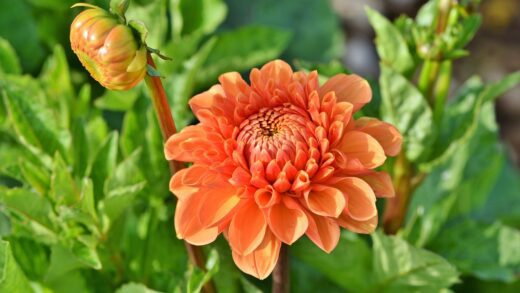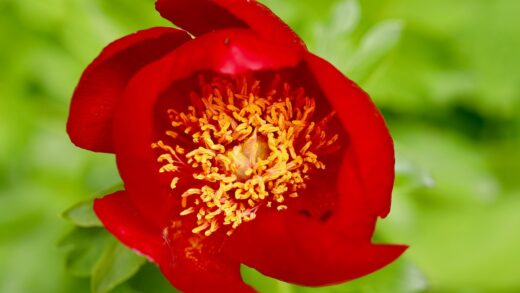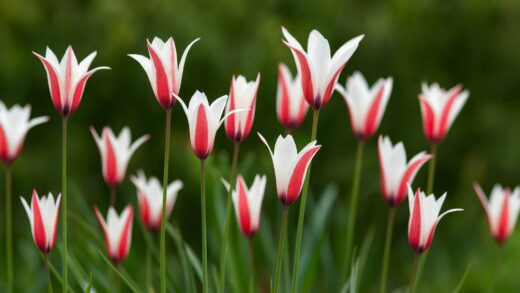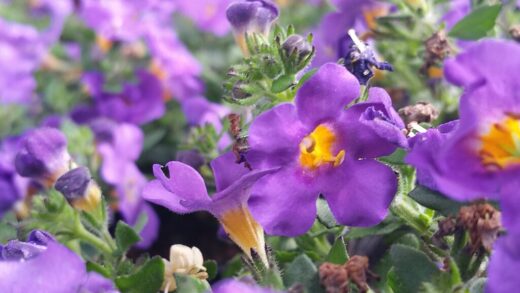The light requirements of sea thrift are straightforward and non-negotiable: it is a quintessential full-sun plant. Its entire biology is adapted to open, exposed environments where it receives direct, unfiltered sunlight for the majority of the day. This abundant light energy is the fuel for its dense, compact growth and, most importantly, for the prolific production of its iconic, colorful flowers. Providing anything less than its required quota of sunlight will invariably lead to a plant that is a pale imitation of its true potential, resulting in disappointment for the gardener and a struggle for the plant itself.
To thrive and perform at its best, sea thrift needs a minimum of six to eight hours of direct sunlight each day during the growing season. This means a location with an open, southerly or westerly aspect is ideal, where it will not be overshadowed by buildings, trees, or larger perennials. In these conditions, the plant will develop into a tight, resilient mound of deep green foliage and will produce a spectacular display of blooms from late spring into summer. The intensity of the light is just as important as the duration; dappled or filtered light, even for a full day, is not a suitable substitute for direct sun.
The consequences of insufficient light are quickly apparent. A sea thrift plant grown in partial shade will become etiolated, meaning its foliage will be long, lanky, and weak as it stretches in a desperate attempt to reach for more light. The characteristically neat, cushion-like habit will be lost, replaced by a sparse and floppy appearance. The plant’s overall structure will be compromised, making it more susceptible to damage from wind and rain.
Most significantly, a lack of adequate sunlight will severely inhibit flowering. Flower production requires a tremendous amount of energy, and for sea thrift, this energy comes directly from intense sunlight. A plant in a shady location may produce a few meager flowers, or more likely, none at all. If you have a sea thrift that is growing but not blooming, the first and most probable cause to investigate is whether it is receiving enough direct sun throughout the day.
The importance of full sun
Full sun is critical for the process of photosynthesis, which is how plants convert light energy into the chemical energy they need to grow and function. For a plant like sea thrift, which is adapted to high-light environments, this process is optimized for intense sun exposure. The strong sunlight fuels the production of carbohydrates that are essential for building strong cell walls, developing a robust root system, and, crucially, forming flower buds. Without this high level of energy production, the plant simply lacks the resources to perform these vital functions effectively.
More articles on this topic
The compact, mounding growth habit of sea thrift is also a direct response to high light levels. In full sun, the plant does not need to waste energy on long stems and leaves; it can maintain a low, dense form that is efficient and resilient. This habit is an adaptation to the often windy and exposed conditions of its native habitats, helping it to conserve moisture and remain anchored. When light is limited, the plant’s hormonal balance shifts, promoting stem elongation over dense growth, leading to the weak, leggy form seen in shaded specimens.
Furthermore, direct sunlight plays a crucial role in preventing fungal diseases. The intense sun and the heat it generates help to quickly dry the foliage after rain or morning dew. This reduces the amount of time that moisture lingers on the leaves and around the crown, creating an environment that is inhospitable to the germination and spread of fungal spores. In a shadier, damper location, the foliage stays wet for longer, dramatically increasing the risk of diseases like rust and crown rot.
Finally, the vibrant coloration of both the foliage and the flowers is often more intense in plants grown in full sun. The pigments that give the flowers their rich pink, magenta, or white hues develop more fully under high light conditions. Similarly, the deep green of the foliage is maintained in full sun, whereas in shade, it may appear a paler, less vigorous green. For gardeners seeking the maximum ornamental impact, providing full sun is the key to unlocking the plant’s full genetic potential for color and form.
Identifying light-related problems
Identifying problems related to inadequate light in sea thrift is usually quite straightforward, as the symptoms are distinct and predictable. The most obvious sign is a lack of flowering. If a mature plant fails to produce any blooms or only sends up a few sporadic, weak flower stalks, insufficient sunlight is almost certainly the cause, assuming other factors like drainage are adequate. This is the plant’s way of conserving its limited energy resources for basic survival rather than for the costly process of reproduction.
More articles on this topic
Another key indicator is the plant’s overall form and habit. A healthy, sun-grown sea thrift forms a tight, dense, almost hemispherical cushion of foliage. In contrast, a light-deprived plant will have a much looser, more open structure. The individual grass-like leaves will be longer and more spaced out, and the entire clump may appear flattened and untidy. This stretching, or etiolation, is a clear sign that the plant is not receiving the light intensity it needs to maintain its characteristic compact form.
The color of the foliage can also be a clue. While some yellowing can indicate overwatering, a general pale green or washed-out appearance, rather than a deep, rich green, can suggest a lack of sunlight. The plant is unable to produce chlorophyll as efficiently in low light, leading to this lackluster coloration. In some cases, the foliage may even appear yellowish, particularly the older leaves at the base of the plant.
Observing the plant’s location throughout the day is the definitive diagnostic step. Many gardeners underestimate how much shade a spot receives as the sun moves across the sky. A location that seems sunny in the morning may be in deep shade by the afternoon due to a nearby tree, fence, or building. Use a sun calculator or simply make a point of checking on the plant every hour or two on a sunny day to get an accurate assessment of how many hours of direct, unobstructed sunlight it is truly receiving.
Ideal placement in the garden
Given its need for full sun and excellent drainage, sea thrift is perfectly suited for several specific locations within a garden design. A classic and ideal placement is in a rock garden or alpine trough. These settings naturally provide the sharp drainage and lean soil that sea thrift loves, and their open nature typically ensures maximum sun exposure. The plant’s neat, mounding habit looks perfectly at home nestled among rocks and gravel, where its fine texture can contrast beautifully with the hardscape elements.
Another excellent location is at the front of a sunny border or along the edge of a pathway. In this position, it will not be overshadowed by taller perennials behind it, and its low-growing, evergreen nature provides a clean, tidy edge to the planting bed throughout the year. When planted in drifts or groups along a border, it can create a stunning ribbon of color during its blooming season. Pairing it with other sun-loving, drought-tolerant plants like sedum, lavender, or ornamental grasses will create a cohesive and low-maintenance planting scheme.
Sea thrift is also a prime candidate for coastal or seaside gardens, where it is in its element. Its natural tolerance for salt spray and windy conditions means it will thrive in locations where other, more delicate plants would perish. It can be used to stabilize soil on sunny banks or slopes, where its deep root system can help to prevent erosion. In these exposed sites, its tough, resilient nature is a significant asset.
Finally, sea thrift is an excellent choice for container gardening, provided the pot is placed in the sunniest part of a patio, balcony, or deck. A terracotta pot filled with a gritty, well-draining soil mix makes an ideal home. This allows you to provide the perfect growing conditions even if your garden soil is heavy clay. In a container, its charming form and long-lasting flowers can be appreciated up close, bringing a touch of durable beauty to any sunny outdoor living space.
Adjusting for different climates
While the requirement for full sun is universal for sea thrift, some minor adjustments in siting may be beneficial in very different climates. In cooler, northern climates with less intense summer sun, it is imperative to place the plant in the sunniest, most open, and warmest spot in the garden. A south-facing slope or a position against a heat-radiating stone wall can provide the extra warmth and light intensity needed to ensure a robust performance. In these regions, there is little to no risk of the sun being too strong.
Conversely, in extremely hot, arid climates, such as the desert southwest of the United States or Mediterranean regions with scorching summers, sea thrift can sometimes benefit from a small amount of relief from the most intense afternoon sun. While it still needs at least six hours of direct sun, providing it with sun from the morning until early afternoon, followed by very light, dappled shade during the hottest part of the day, can prevent the foliage from scorching and reduce overall plant stress. However, deep shade is still to be strictly avoided.
In climates with very high humidity, the full sun requirement is coupled with an even greater need for excellent air circulation. In these regions, it is especially important to avoid planting sea thrift in enclosed courtyards or densely packed beds where air can become stagnant. An open, slightly breezy location will help to keep the foliage dry and ward off the fungal diseases that are more prevalent in humid conditions. The drying power of the sun and wind is a key component of its health in these environments.
Regardless of the climate, the fundamental rule does not change: sea thrift is a sun plant. The adjustments are about optimizing its placement within that context. The goal is always to provide as much direct sun as possible, only considering slight afternoon protection in the most extreme hot-summer climates. For the vast majority of gardeners, the simplest and most effective strategy is to find the sunniest, best-drained spot available and plant it there.




















